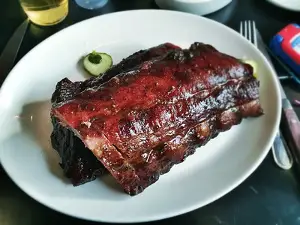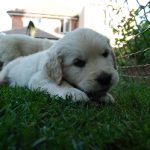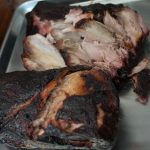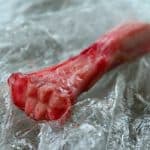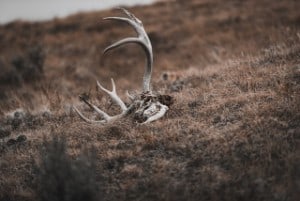
Have you heard about how great antlers are as dog chews?
And you think that you have found a handy shortcut, an antler hack from one of your local walks.
Why buy ready made antler chews for dogs, when you can get them for free on your local walks?
But, can you give a dog an antler that you found in the woods?
Let’s find out..
Can I give my dog a deer antler I found in the woods?
No. For the price of buying a piece of deer antler for your dog from a local shop or online store, it is not worth the risk of giving your dog a deer antler that you found in the woods.
What are antlers?
Antlers are an extension of the skull made up of bone, cartilage, tissue, skin and blood vessels.
Antlers are normally only found on male animals although they are found on male and female reindeers.
Antlers serve two purposes.
Firstly to make a male animal sexually attractive and secondly to be used as a weapon in fights over females.
What animals have antlers?
When I think of antlers, I think of deer.
But deer aren’t the only animals to have antlers.
Other animals that have antlers are elk, reindeer and moose.
In the UK, you will only come across antlers from deer.
But in the US you will find antlers from deer, elk and moose.
Reindeer (or Caribou) now only inhabit Alaska in the US and so unless you are in Alaska, you won’t find any Caribou antlers in the woods!
How do they lose antlers?
Antlers are shed every year.
They are thought to be the fastest growing animal bone in the whole animal kingdom.
Whilst the bone is growing, it remains quite soft. Once it dies, it becomes a mature and hard antler.
Why are “found” deer antlers dangerous?
If you find a wild antler in a wood whilst you were out walking then there is one very good reason why it isn’t a good idea to let your dog chew on them.
And this is because you have no idea of the age of the antler.
Deer antlers that you buy from a shop for your dog to chew are made from fresh antlers- that were harvested from the deer only weeks before.
The antler that you find in the woods might be much older.
And older antlers are more likely to be infected with nasty bacteria.
And older antlers become harder and more brittle and therefore more likely to break or damage your dog’s teeth when they chew on them.
Fresh antlers vs old antlers- spot the difference
As antlers age, they change colour.
When they are still living (on a deer’s head) they are a brown and white colour.
But, when they drop off the head and start to age, they change from a brown and white to a brown and yellow colour.
But, how easy it is for a novice or newbie like you or I to really know the difference between fresh antlers and old or aged antlers.
So it might be that the antler that you have found is “as fresh as a daisy” but are you confident of telling the difference between a fresh and old pair of antlers?
Deer antlers vs. bones
Most dog owners have grown up with an image of a dog with a bone and what I mean by this is that we just wouldn’t question whether or not a dog should chew a bone.
To which the common answer is “of course dogs should chew bones because it is the most natural thing in the world.”
And so by extension, we could say the same about antlers- that there is nothing wrong with dogs chewing antlers because they are kind of like bones.
Chewing bones or antlers do have some advantages to dogs.
Firstly, are the nutrients such as calcium that they get from chewing on a bone or antler.
But most dry and wet foods are complete diets and have all of the minerals and vitamins that dogs need.
Secondly, is the mental stimulation that dogs gain from chewing on bones and the like.
Although you could argue that, in terms of stimulation a dog would be better off puzzling out a food filled Kong or completing the odd agility course or two.
The real dangers that bones and antlers pose to your dog comes from the potential damage that bones and antlers can do to your dog’s teeth and mouth.
Here are a few shocking statistics for you.
Forgetting antlers for a minute, 70- 80% of all dogs show some signs of an oral disease by the time that they are three years old.
And between 10- 20% of all dogs will fracture one tooth or more in their lifetime.
So, if bones and antlers are off the chewing menu, what is on it?
The best dog chew
And the winner in this category is…
Well I don’t think that there is a winner, I am not convinced that there is one object that is a perfect fit for all dogs.
Any bone or chew toy of any variety will have their upsides and downsides.
Tennis balls? Yes, they are great because they are soft and my dog loves tennis balls.
The trouble is that the yellow fur that covers a tennis ball is actually quite abrasive for dogs teeth.
What about a nylon chew toy? Again, the nylon is very abrasive on a dog’s teeth.
And so to me, the best thing for your dog to chew on is a variety of objects.
A bit of little and often.
On some days let them have a bone, other days an antler and the next week their nylon chew toy.
Way more important is not what they chew but how they chew.
And for me, there are two golden rules.
[1] Time
Only let them chew on an object for short periods of 15 minutes to 30 minutes
[2] Alone
Never let them chew on anything when you aren’t around.
Just in case a tooth breaks or they literally bite off more than they can chew and it ends up choking them.
Five steps to prepare antlers that you have found in the woods
In spite of some of my advice to steer clear of deer antlers that you found in a wood, you want to go ahead and give them to your dog.
Is there any preparation that you should do?
There are four steps that you should take in order to make these antlers as safe as possible for your dog.
Step 1: Healthy
As we said earlier, ideally you want an antler which has only fallen off in the last few months.
The most important thing to check for is that the antlers are hard and they don’t seem to be decaying or softening in anyway.
You can also use the colour test and the smell test.
What colour are the antlers?
Anything which looks too yellow should be avoided.
And how do the antlers smell?
If they have a very strong or rotten odour to them then steer well clear.
Unless the reason that they smell so bad is that they are covered in deer poop!
If they pass the health test, it is time to move onto step 2.
Step 2: Saw off sharp edges
As I have banged on and on about antlers are very hard.
The next step is to cut the pointed ends off the antlers.
The challenge with cutting them is to find a saw or a blade that is sharp enough to cut through the antlers safely.
And that is no easy task.
If you read this forum thread, there are a couple of suggestions including a hacksaw or a diamond blade on a tile cutter.
Step 3: Cut them to size
Depending on the size of the antler, you will probably want to cut them down into smaller chunks.
And the exact size depends on the size of your dog’s mouth.
Too small and your dog might try to eat and swallow it down whole (and risk choking) and too large and your dog will struggle to be able to chew any part of it.
Step 4: Wipe and smooth
Having done all that cutting, you need to make a couple of final checks.
Wipe down your pieces of antlers to make sure that there are no sharp edges or splinters on them
Step 5: Boil and cool
Your last step is perhaps the most important one for your antlers and that is to boil and sterilise them.
Just stick in a pan of boiling water for about thirty minutes.
Take them out, let them cool and then the antlers are dog ready!
Should you soften deer antlers for dogs?
If antlers are too hard for dogs, wouldn’t it be a good idea to soften them?
After all, it doesn’t make any sense to risk your dog breaking or fracturing a tooth, does it?
The trouble is that softening an antler doesn’t make them totally safe either.
However, I have written a more detailed guide to softening deer antlers which you can read here.

